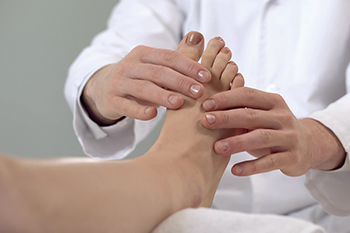Connect With Us
Blog
Items filtered by date: October 2022
Several Areas of the Foot Can Be Painful

There are several areas of the foot that can become painful. Some people experience toe pain, heel pain, or even toenail pain when specific shoes are worn, or activities are pursued. Plantar fasciitis is a common foot condition that can cause severe pain and discomfort, and treatment is suggested to begin at the first signs of pain. Heel pain is often associated with this condition, and may radiate to the Achilles tendon. Toe pain may be the result of the ailment known as gout, or it may develop from having a bunion. Additionally, corns can cause extreme pain, especially when one forms on the outside of the pinky toe. Pain in the toenails may be what is referred to as a subungual hematoma, and can happen from excessive rubbing of the toes against the shoe. Extensor tendonitis may be the cause for pain on top of the foot, which can be accompanied by swelling and difficulty in running. If you have pain in any area of your foot, it is strongly suggested that you seek the expert advice from a podiatrist who can determine why it is occurring, and treat it accordingly.
Foot Pain
Foot pain can be extremely painful and debilitating. If you have a foot pain, consult with Rahil Baxamusa, DPM from Illinois. Our doctor will assess your condition and provide you with quality foot and ankle treatment.
Causes
Foot pain is a very broad condition that could be caused by one or more ailments. The most common include:
- Bunions
- Hammertoes
- Plantar Fasciitis
- Bone Spurs
- Corns
- Tarsal Tunnel Syndrome
- Ingrown Toenails
- Arthritis (such as Gout, Rheumatoid, and Osteoarthritis)
- Flat Feet
- Injury (from stress fractures, broken toe, foot, ankle, Achilles tendon ruptures, and sprains)
- And more
Diagnosis
To figure out the cause of foot pain, podiatrists utilize several different methods. This can range from simple visual inspections and sensation tests to X-rays and MRI scans. Prior medical history, family medical history, and any recent physical traumatic events will all be taken into consideration for a proper diagnosis.
Treatment
Treatment depends upon the cause of the foot pain. Whether it is resting, staying off the foot, or having surgery; podiatrists have a number of treatment options available for foot pain.
If you have any questions, please feel free to contact our office located in Crystal Lake, IL . We offer the newest diagnostic and treatment technologies for all your foot care needs.
Are You Suffering From Nerve Damage?
What Does Sever’s Disease Feel Like?

- Sever’s disease, or calcaneal apophysitis, is a particular kind of foot condition that can occur in children when microfractures develop near where the Achilles tendon meets the heel bone. Young boys are most susceptible to developing Sever’s disease, often from overuse due to playing sports or other physical activities. Although it may vary from person to person, Sever’s disease often produces a kind of heel pain. In some patients, the heel pain can be quite painful. A child may have a severe kind of heel pain that causes limping. Oftentimes, a child will not feel any swelling around the affected area. Sever’s disease can sometimes feel like plantar fasciitis, another source of heel pain. However, one important distinction between the two is that heel pain from plantar fasciitis is typically most pronounced at the beginning of the commencement of movement and will then go away. If you suspect that your child has Sever’s disease, consult a podiatrist today.
Sever's disease often occurs in children and teens. If your child is experiencing foot or ankle pain, see Rahil Baxamusa, DPM from Illinois. Our doctor can treat your child’s foot and ankle needs.
Sever’s Disease
Sever’s disease is also known as calcaneal apophysitis, which is a medical condition that causes heel pain I none or both feet. The disease is known to affect children between the ages of 8 and 14.
Sever’s disease occurs when part of the child’s heel known as the growth plate (calcaneal epiphysis) is attached to the Achilles tendon. This area can suffer injury when the muscles and tendons of the growing foot do not keep pace with bone growth. Therefore, the constant pain which one experiences at the back of the heel will make the child unable to put any weight on the heel. The child is then forced to walk on their toes.
Symptoms
Acute pain – Pain associated with Sever’s disease is usually felt in the heel when the child engages in physical activity such as walking, jumping and or running.
Highly active – Children who are very active are among the most susceptible in experiencing Sever’s disease, because of the stress and tension placed on their feet.
If you have any questions, please feel free to contact our office located in Crystal Lake, IL . We offer the newest diagnostic and treatment technologies for all your foot and ankle injuries.
Various Types of Wounds on the Feet

A diabetic foot ulcer is a common foot wound. Without prompt medical treatment, it can quickly become infected, possibly lead to gangrene, and amputation. There are different types of foot ulcers, and they fall into three categories. There are diabetic foot wounds that are considered to be neuropathic, and the patient generally loses sensation but there is no underlying arterial disease (ischemia). This comprises approximately 35% of foot wounds. An ischemic wound occurs when the patient retains feeling in the foot but there is an indication of underlying arterial disease. The neuroischemic bracket represents 50% of all foot wounds, and both iscehemia and neuropathy can be present. Effective healing begins with having a healthy environment for the wound to heal, in addition to the patient having little or no health issues. Most wounds begin healing by accessing the cause of the wound, followed by removing any damaged tissue from it. It is beneficial to refrain from putting any weight on the foot, and this may help to accelerate the healing process. Treating a wound on the foot is often done by a podiatrist, and it is suggested that you contact this type of doctor who can effectively provide relief treatments.
Wound care is an important part in dealing with diabetes. If you have diabetes and a foot wound or would like more information about wound care for diabetics, consult with Rahil Baxamusa, DPM from Illinois. Our doctor will assess your condition and provide you with quality foot and ankle treatment.
What Is Wound Care?
Wound care is the practice of taking proper care of a wound. This can range from the smallest to the largest of wounds. While everyone can benefit from proper wound care, it is much more important for diabetics. Diabetics often suffer from poor blood circulation which causes wounds to heal much slower than they would in a non-diabetic.
What Is the Importance of Wound Care?
While it may not seem apparent with small ulcers on the foot, for diabetics, any size ulcer can become infected. Diabetics often also suffer from neuropathy, or nerve loss. This means they might not even feel when they have an ulcer on their foot. If the wound becomes severely infected, amputation may be necessary. Therefore, it is of the upmost importance to properly care for any and all foot wounds.
How to Care for Wounds
The best way to care for foot wounds is to prevent them. For diabetics, this means daily inspections of the feet for any signs of abnormalities or ulcers. It is also recommended to see a podiatrist several times a year for a foot inspection. If you do have an ulcer, run the wound under water to clear dirt from the wound; then apply antibiotic ointment to the wound and cover with a bandage. Bandages should be changed daily and keeping pressure off the wound is smart. It is advised to see a podiatrist, who can keep an eye on it.
If you have any questions, please feel free to contact our office located in Crystal Lake, IL . We offer the newest diagnostic and treatment technologies for all your foot care needs.
Swollen Feet From Flying

An individual’s feet may swell due to pregnancy, excessively eating salty foods, or being obese. However, swollen feet may also develop from flying in an airplane. During a flight, an individual can experience swelling of the feet, or what is known as gravitational edema, from sitting for a long period of time. This essentially causes the blood in your body to accumulate at your feet during flights. If you are sitting in a very restricted position during a flight, this might exacerbate the extent to which you may experience swelling of the feet. Oftentimes, the swelling will subside shortly after getting off of the plane and beginning to walk around again. If you are taking a flight in the near future and are curious about potential swelling of your feet, contact a podiatrist today.
Swollen feet can be a sign of an underlying condition. If you have any concerns, contact Rahil Baxamusa, DPM of Illinois. Our doctor can provide the care you need to keep you pain-free and on your feet.
Swollen feet are a common ailment among pregnant women and people who stand or sit for extended periods. Aging may increase the possibility of swollen feet and patients who are obese often notice when their feet are swelling too. There may be medical reasons why swollen feet occur:
- Phlebitis - A condition that causes the veins to become inflamed and can also cause leg pain.
- Liver disease - This may lead to low blood levels of albumin which is a protein. This can cause fluid in the blood to pass into the tissues and several areas of the body can become swollen.
- Heart failure - When the heart doesn’t pump properly the blood that is normally pumped back to the heart can pool in the veins of the legs causing swollen feet.
- Kidney disease - One of the main functions of the kidneys is releasing excess fluid in the body. This type of condition can make it difficult for the kidneys to function properly, and as a result the feet may become swollen.
- Deep-vein thrombosis (DVT)- This is a serious condition where blood clots form in the veins of the legs. They can block the return of blood from the legs to the heart which may cause the feet to swell. It is important to be treated by a podiatrist if this condition is present.
Swollen feet can also be caused by bone and tendon conditions, including fractures, arthritis, and tendinitis. Additionally, there may be skin and toenail conditions and an infection may cause the feet to swell. Patients who take medicine to treat high blood pressure may be prone to getting swollen feet.
Many patients elevate their feet to help relieve the swelling and this is generally a temporary remedy. When a podiatrist is consulted the reason behind the swelling can be uncovered and subsequently treated.
If you have any questions please feel free to contact our office located in Crystal Lake, IL . We offer the newest diagnostic tools and technology to treat your foot and ankle needs.
Blog Archives
- May 2024
- April 2024
- March 2024
- February 2024
- January 2024
- December 2023
- November 2023
- October 2023
- September 2023
- August 2023
- July 2023
- June 2023
- May 2023
- April 2023
- March 2023
- February 2023
- January 2023
- December 2022
- November 2022
- October 2022
- September 2022
- August 2022
- July 2022
- June 2022
- May 2022

